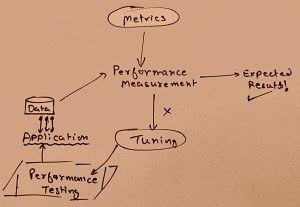Click on images to enlarge
-> Test the parts of the application that have changed since the last cycle / go live
This part of the test plan is very obvious: test the changes to the application. Each change needs to be tested individually if possible, or as groups if the number of changes is large, and is known by the name regression testing.
For example, if you added a new field called ‘maximum pay by date’ to the voucher batch interface, then you could test the interface for this – having both data with this date entered, and with this date set to blank.
There is nothing more to this one – its normally the facet of testing that does receive the due focus during testing.
-> Test sampled parts of the application that have NOT changed
Now we come to something that does NOT receive the due focus. The parts of the application that remained unchanged. No, you do not have to test ALL if it. If you can test all of the application (especially with automated tools, as discussed below) – nothing like it. However, at least test 10-15% of functionality that has not changed.
For example – as discussed above – if you changed the voucher batch interface, then you can test the online voucher entry. Under the online voucher entry, test at least one scenario that has not changed.
The rule of the thumb is that if in a module having 100 test cases, 40 have changed – then test those 40 that have changed, and test 6-10 of those 60 that have not changed.
-> Look at it from the end users perspective: do one full cycle end to end
Next to include in the plan is something you can call integration testing: if your application is about users entering vouchers and getting paid – perform this cycle as a user would do. Many times we IT folks test only our application – the one we are developing and forget the rest of the glue technology. It falls into the category where we want to do it, yet are lazy at – so we find some short-cuts.
Once I was asked to carry out testing for a reconciliation report that had already been tested by the developers. I uploaded the same input twice, which ended up showing double on the final report. It turned out that the developer had missed this because he tested only on the basis of data that already existed in the system, and did not upload any new vouchers.
-> Stress testing
Stress testing should again be a very critical part of your test plan. How many users are expected to use the application? during normal hours? during peak hours? Plan for all such scenarios. Design the business process that would take place if the application does fail – the idea should be that the user’s work doesn’t get halted.
There are stress testing tools available both free and commercial that you can use to simulate users.
In one of my projects, a web application that was created for 800 users, failed under a load of 35. Increasing the number of processors, or the number of server boxes is not a guaranteed way of handling load on the application: the application has to be designed to support the load from the ground up, and tested suitably.
-> Performance testing
How long does a file take to get processed? How long does the user expect it to take? How long it takes for the screen to open/save?
The user expectation part is sometimes ignored. Please go ask the users of your application now what their expectation is – or it might already be too late in terms of coding.
The developers might think if a process runs for one hour its good enough. However, the users might be needing to run it six times a day during the closing period. Hence one hour might not be fast enough. In such a scenario we had to run four parallel instances of a process to achieve the user specified timing.
-> Concurrency testing
Can two different instances of the new process run together? The panel you just created: can it be used by two persons at the same time? Does it cause deadlocks at the database level if 100 instances of the process are run together?
Can two different versions of the application exist on the same machine?
These are the kind of questions that you ask yourself while working on the ‘concurrency’ aspect of test plan/execution.
A team of developers once needed to clone a process, and create slightly different functionality. However, it turned out that when both the processes were run together, 1 times in 10, one of the processes would fail. This was noted after go live 🙂 Turned out the cause was incorrect use of the shared temporary tables by one of the processes.
If you are interested in Deadlocks technically please read my posting: “Oracle Deadlocks: the What & the How“.
-> Unit test before Integration testing
Our laziness at work again: we ‘trust’ our work and want to move directly to integration testing. Partially, the waterfall model of software development is also to blame here.
99% of the times, after the developer moves directly to integration testing – the very first test case for the application fails, and the developer comes back to the unit testing phase. 🙂
Unit testing is a very critical part of your test plan – if you do it right, you will find hundreds of issues that will otherwise never get detected. Even not during integration testing.
Build ‘driver modules’ to iterate through all the ‘ifs and whiles’ that have been coded. Try out all avenues control can flow through.
-> Create test history
Creation of a test history is as important as doing the testing. Being able to, at a later date, answer such questions as: ‘what are cases we tested?’, ‘what are the problems we found?‘ etc is very helpful. Showing a clean slate (a ‘pass’ on all test cases) at the end of all our test iterations is not so helpful. In short, record the problems found, even though they may get corrected later on.
-> Automated testing
Automated testing solutions can be a big help. It does not mean that all testing be delegated to the automated testing mechanism: but it can definitely be an add-on to your manual testing.
In changing the order entry functionality, use it to enter 1000 different orders. There are several solutions available (use google) that will record the user actions, and will repeat those actions later with different data.
At a very simple level, AutoIt is a great tool for automated data entry, and is free (GPL). Its very flexible and has a great library of functions built into its scripting language. I use it all the time, and not just for testing!
-> Code review
While we focus on all these great ways of testing let us not forget our tried and tested workhorse: code review. Being humans, we are tempted to feel that by doing better testing (being easier to do) we can offset the need for a good code review, but there are hundreds of reasons to do code review.
There may be some program flows designed for rare situations which may never get tested. Code review in such a case will contribute ideas for such test cases. Documentation may not be in sync with the code, with the potential to make future changes difficult. There may be code improvements possible: for example, replacing an ‘if condition’ with a more specific check.
There are other things, depending on your scope you may also want to include them:
-> Knowledge transfer/competence testing
-> Backup & recovery testing
All the best, post your comments here.




